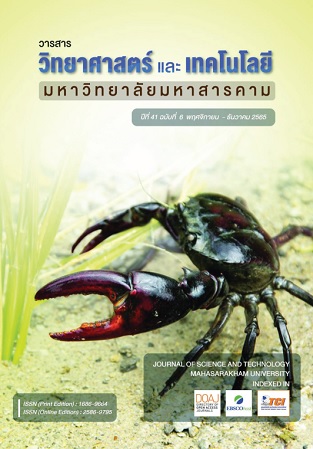Optimization of pectin extraction from possum purple passion fruit peel (Passiflora edulis) with fruit acids
Main Article Content
Abstract
Pectin is a heteropolysaccharide polymer compound present in the primary cell walls of plants, where it binds cells
together. It will swell into a gel, acting as a gelling agent, when it is dissolved in water. It is used as a thickening agent,
especially in jams and jellies, as well as a source of dietary fiber. The purpose of this study is to study the extraction
of pectin from possum purple passion fruit peel and to optimize conditions for fruit acid pectin extraction using kaffir
lime juice compared to lemon ‘Pan Phichit’ juice and bitter orange juice. The pectin yields were 12.74%, 11.92%
and 10.82%, respectively. The pectin extracted from fruit acids was low methoxyl pectin. Determination of the ideal
conditions for kaffir lime juice extraction employed response surface methodology using Box-Behnken Design (BBD).
It was found that the extraction time of 120 min, 90 °C, and L:S ratio 15:1 ml/g resulted in the highest %yield of
12.81%. The results of the experimental design confirmed that the pectin extraction model could be used as a guide
for the extraction of pectin from other fruit peel.
Article Details
References
ชวนิฎฐ์ สิทธิดิลกรัตน์, พิลาณี ไวถนอมสัตย์ล จิราพร เชื้อกูล และปริศนา สิริอาชา. (2548). การผลิตเพคตินจากเปลือกและกากผลส้มเหลือทิ้ง. [วิทยานิพนธ์]. มหาวิทยาลัยเกษตรศาสตร์. กรุงเทพฯ.
ธานุวัฒน์ ลาภตันศุภผล, ปฏิมา ทองขวัญ และศิริลักษณ์ สรงพรมทิพย์. (2556). การสกัดเพคตินจากเปลือก ผัก และผลไม้. [วิทยานิพนธ์]. กรุงเทพฯ: มหาวิทยาลัยเทคโนโลยีพระจอมเกล้าพระนครเหนือ.
พงษ์เสริฐ ศรีพรหม กญั ญารัตน์ เกิดศิริ พรสวรรค์ อัศวแสงรัตน์ และ ปธานิน แสงอรุณ. (2561).การหาสภาวะที่เหมาะสมของการสกัดเพคตินจากเปลือกทุเรียนด้วยน้ำส้มสายชู. วิศวสารลาดกระบัง ปีที่ 35 ฉบับที่ 3 – 4 กันยายน – ธันวาคม.
สุรีวัลย์ สิมชาติ สุภาวิตา บุดดาเวียง นิภาพร พลเยี่ยม และ วัฒนา อัจฉริยะโพธา. (2562). การสกัดเพคตินจากเปลือกส้มซ่าเพื่อผลิตแยมส้มซ่า. การประชุมวิชาการระดับชาติ วิทยาศาสตร์และเทคโนโลยีระหว่างสถาบัน ครั้งที่ 7, วันศุกร์ที่ 7 มิถุนายน. มหาวิทยาลัยรังสิต.
อรพิน ภูมิภมร. (2523). คาร์โบไฮเดรตในสารอาหารพอลีแซ็คคาไรด์. [วิทยานิพนธ์]. มหาวิทยาลัยเกษตร- ศาสตร์. กรุงเทพฯ.
Adetunji L.R., Adekunle A., Orsat V., and Raghavan V., (2007). Advances in the pectin production process using novel extraction techniques: A review, Food Hydrocolloids vol 62,. pp. 239-250.
Happi Emaga, T.; Robert, C., Ronkart, S.N., Wathelet, B. and Paquot, M., (2008). Dietaryfibre components and pectin chemical features of peels during ripening in banana andplantain varieties. Bioresource Technology, 99, pp. 4346—4354.
Kurita O., Fujiwara T., and Yamazaki E., (2008). Characterization of the pectin extracted from
citrus peel in the presence of citric acid,
Carbohydrate Polymer. vol 74, pp. 725-730.
Prakash Maran J., (2015). Statistical optimization of
aqueous extraction of pectin from waste durian
rinds, International Journal of Biological
Macromolecules vol 73, pp. 92–98.
Shaha R.K., Nayagi A.P.Y., (2013). Punichelvana and Afandi A., Optimized extraction condition and characterization of pectin from kaffir lime (Citrus hystrix), Research Journal of Agriculture and forestry Sciences vol1(2), pp. 1-11.
Ström A., Ribelles P., Lundin L., Norton I., Morris E.R. and Williams A.K., (2007). Influence of pectin fine structure on the mechanical properties of calcium-pectin and acid-pectin gels. Biomacromolecules vol.8, pp. 2668–2674.
Sukboonyasatit D., Pornnikom N. and Natyay N., (2018). Chemical and physical properties of pectin from okra, Khon Kaen Agriculture Journal, vol 48, pp. 419-1422.
Wai W.W., Alkarkhi F.M.A. and Easa A.M., (2010).
Effect of extraction conditions on yield and
degree of esterification of durian rind pectin : An experimental design, food and bioproducts
processing vol 88, pp. 209–214.
Wilaiwan O. and Choojun S., (2554). Application of pectin crude extracts from Krung Kha Mao leaves (Cissampelos pareira L.) to immobilized cells of Lactobacillus casei subsp. rhamnosus TISTR 108 and Lactobacillus delbrueckii subsp. Bulgaricus TISTR 1339 for lactic acid production, Proceedings of 48th Kasetsart University Annual Conference: Science, Kasetsart University.
Wittayapapakorn S. and Taweekasemsombat S., (2013). The optimum conditions of extracting pectin from agricultural materials. Research Journal Special Issue the 5th Rajamangala University of Technology National Conference: Science, Rajamangala University of Technology.
Yapo, B.M. and Koffi, K. L.. (2006). Yellow passion fruit rind—A potential source of low-methoxyl pectin. Journal of Agriculture and Food Chemistry, 54, Pp.2738-2744. http://dx.doi.org/10.1021/jf052605q


